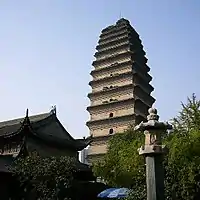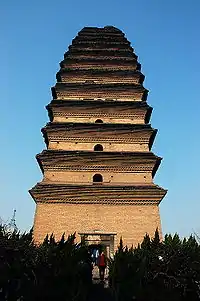Small Wild Goose Pagoda
The Small Wild Goose Pagoda, sometimes Little Wild Goose Pagoda (Chinese: 小雁塔; pinyin: Xiǎoyàn Tǎ), is one of two significant pagodas in Xi'an, Shaanxi, China, the site of the old Han and Tang capital Chang'an. The other notable pagoda is the Giant Wild Goose Pagoda, originally built in 652 and restored in 704.


History
The Small Wild Goose Pagoda was built between 707–709, during the Tang dynasty under Emperor Zhongzong of Tang (r 705–710). The pagoda stood 45 m (147 ft) until the 1556 Shaanxi earthquake. The earthquake shook the pagoda and damaged it so that it now stands at a height of 43 m (141 ft) with fifteen levels of tiers.[1] The pagoda has a brick frame built around a hollow interior, and its square base and shape reflect the building style of other pagodas from the era.[1]
During the Tang Dynasty, the Small Wild Goose Pagoda stood across a street from its mother temple, the Dajianfu Temple. Pilgrims brought sacred Buddhist writings to the temple and pagoda from India, as the temple was one of the main centers in Chang'an for translating Buddhist texts.[1] The temple was older than the pagoda, since it was founded in 684, exactly 100 days after the death of Emperor Gaozong of Tang (r. 649–683).[1] Emperor Zhongzong had donated his residence to the building of a new temple here, maintaining the temple for 200 monks in honor of his deceased father Gaozong.[1] The temple was originally called the Daxianfusi or Great Monastery of Offered Blessings by Zhongzong, until it was renamed Dajianfusi by Empress Wu Zetian in 690.[1]
Architecture
The Small Wild Goose Pagoda is a pagoda of the brick structure, consisting of an underground palace, the base, the body and eaves, and so on. The pagoda is a quadrangular. The top of the pagoda was destroyed two levels during the great earthquake in the 34th year of Jiajing of Ming Dynasty (1556), and the existing 13 levels. The total height of the pagoda was measured in 1989 as 43.395 meters, the bottom side was 11.38 meters long, and the ratio of height to bottom side was 100:26.[2]
The first layer of the Small Wild Goose Pagoda opens a doorway in the north and south of the pagoda for access. The north and south doorframes are made of green stone. The frame of the stone gate is carved with typical Buddhist allegorical decorative motifs, such as the celestial beings and vines, auspicious clouds, and Jalinpura, reflecting the artistic style of the early Tang Dynasty. The Flying Heaven was originally a god of song and dance and entertainment in ancient Indian mythology.
Morning Bell
The bell was cast in the third year of Mingchang in the Jin Dynasty (1192) and is 3.55 meters high and weighs about 8,000 kilograms.
This bell was hanging in the Wugong Chongjiao Temple by the Wei River. When the Wei River flooded and the riverbed was diverted, the temple was destroyed by water and the bell sank in the river bank. During the Kangxi period of the Qing Dynasty, the bell was rediscovered and moved into the bell tower next to the Small Wild Goose Pagoda.
Every morning, the bell is rung regularly in the temple and can be heard for tens of miles. The sound of the bell is clear and the shadow of the tower in the morning sunshine is beautiful, which has a unique flavor in the ancient city. The "Morning Bell of Goose Pagoda" is known as one of the "Top Eight Scenic Spots in Chang'an".
Notes
- Kiang, 12.
- "Small Wild Goose Pagoda Xi'an,China". www.chinatourstar.com. Retrieved 2020-12-21.
References
| Wikimedia Commons has media related to Small Wild Goose Pagoda. |
- Heng Chye Kiang. (1999). Cities of Aristocrats and Bureaucrats: The Development of Medieval Chinese Cityscapes. Singapore: Singapore University Press. ISBN 9971-69-223-6.